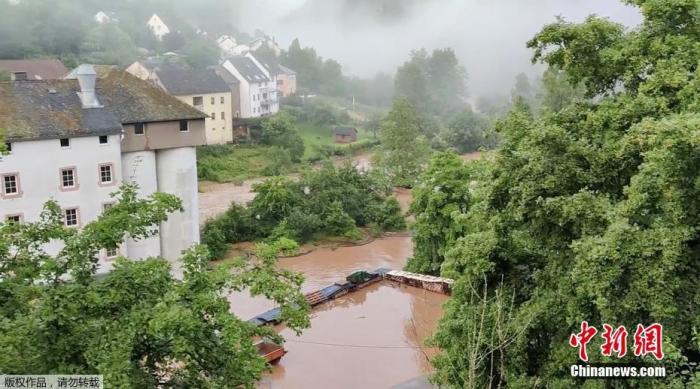China News Service, July 17th. Comprehensive foreign media reported that there have been torrential rains in western Europe for several days, causing severe floods. 103 people have been killed in Germany. Due to the interruption of communications and transportation, 1,300 people are still missing; in Belgium, at least 20 people have also been killed. , The Netherlands, Luxembourg and Switzerland were also affected by the floods.
In the hardest-hit area in western Germany, the village was reduced to Zeguo, the vehicle was overturned, and the military dispatched helicopters and tanks to join the rescue operation.
Scientists warn that in the context of global climate change, similar extreme weather may become more frequent in the future.
On July 15, local time, after heavy rains in Valkenburg, the Netherlands, lifeguards rode rescue vehicles through the flooded road.
According to a comprehensive report by Hong Kong's "Ta Kung Pao", due to the impact of low pressure, heavy rains have been continuous in western Europe since the 14th.
Among the many affected areas, western Germany was the worst affected. The 24-hour rainfall in some areas exceeded 150 mm, which is the local rainfall for the entire month, which has exceeded the level that the ground and sewer systems can absorb and carry.
Coupled with the bursting of many rivers, the flood was out of control.
So far, 103 people have been killed in Germany, and this number is expected to continue to increase.
German Chancellor Angela Merkel, who is visiting the United States, said that the flood was a fatal "disaster" and expressed sympathy for the relatives of the dead and missing, and promised that the government will do its utmost to help the people get out of trouble.
She also warned that the final scale of the disaster will only be clear in the next few days.
On July 15th, local time, after a heavy rain in Kyllburg, Germany, floods flooded.
German village reduced to Ze State
The military disaster alert was activated and the authorities dispatched tanks to clear obstacles
In the western part of Germany, villages were reduced to Zeguo, streets and houses were flooded, vehicles were overturned, and trees were uprooted.
German Defense Minister Karenbauer announced on the 16th that a military disaster alert was activated and ordered the suspension of all other domestic missions.
She said that the current “top priority” is disaster relief work.
Approximately 15,000 police, soldiers and emergency rescuers were deployed to search and rescue the disaster area, and helicopters were dispatched to rescue residents on the trapped roof, tanks were towed away trapped cars, and trees and ruins on the road were cleared.
Ahrweiler County in the Rhineland-Palatinate state is located on the banks of the Ahr River, and the disaster situation is severe.
A middle-aged couple in Ahrweiler County told Deutsche News Agency that the river suddenly burst into the town, "Pedestrians and vehicles on the street disappeared from our eyes. This overwhelming sense of despair makes people feel like It's useless to escape for your life."
In Ahrweiler County alone, as many as 1,300 people are missing. Officials explained that this alarming number was caused by the interruption of traffic and mobile networks, and many residents were unable to contact.
So far, many remote villages are still completely disconnected from the outside world.
In addition, rainfall continued to "dangerously rise" the water level of the Rhine and several tributaries. As many dams are at risk of dam failure, nearby residents have to be evacuated urgently.
In Hemmerzheim, the Swister River, usually 2 meters wide, soared to 200 meters wide, flooding the basements and ground floors of entire town houses.
On the 16th, a landslide occurred in the suburb of Blessem near Cologne, killing many people.
The German "Bild" described the disaster as a "death flood", far surpassing the German "century flood" that killed 21 people in 2002.
In 1962, more than 300 people were killed in the floods in Hamburg.
On July 15, local time, in Hognur, Belgium, a woman stood on a flooded road in front of her house.
At least 20 people died in the same disaster in Belgium
Proclamation of National Day of Mourning
At the same time, at least 20 people died in Belgium, which borders Germany.
The country’s Prime Minister De Crowe said that this may be the worst flood in the country’s history and declared July 20 as a national day of mourning.
In addition, Luxembourg, the Netherlands and Switzerland are also affected, and thousands of people need to be evacuated urgently.
Experts and officials generally believe that the flooding in Europe this time is directly related to climate change.
Meteorologists have found that for every degree Celsius increase in air temperature, its water content increases by 7%.
Global climate warming will also accelerate the evaporation of water on the surface and oceans, which in turn will trigger strong rainfall and storms.
Since the Industrial Revolution, the average temperature in Germany has risen by about 2 degrees Celsius. Experts warn that such extreme weather will become more frequent in the future.
In addition, the German Bundestag elections will be held in September. The ruling CDU’s Raschelt, the Social Democratic Party’s Schultz and the Green Party’s Belberk are regarded as the three most likely candidates to succeed Merkel.
The governor of North Rhine-Westphalia, Raschelt, visited the disaster area on the 15th and called for strengthening "climate protection measures" on a regional, national and global scale.
The analysis pointed out that this flood may push the response to climate change further to the forefront of the German election.

